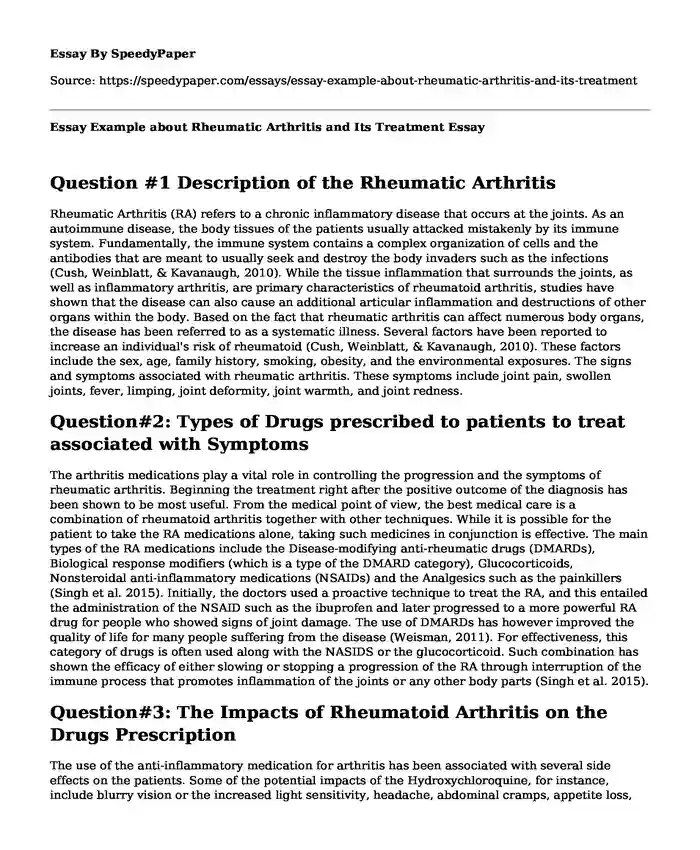
| Type of paper: | Essay |
| Categories: | Medicine Pharmacology |
| Pages: | 3 |
| Wordcount: | 663 words |
Question #1 Description of the Rheumatic Arthritis
Rheumatic Arthritis (RA) refers to a chronic inflammatory disease that occurs at the joints. As an autoimmune disease, the body tissues of the patients usually attacked mistakenly by its immune system. Fundamentally, the immune system contains a complex organization of cells and the antibodies that are meant to usually seek and destroy the body invaders such as the infections (Cush, Weinblatt, & Kavanaugh, 2010). While the tissue inflammation that surrounds the joints, as well as inflammatory arthritis, are primary characteristics of rheumatoid arthritis, studies have shown that the disease can also cause an additional articular inflammation and destructions of other organs within the body. Based on the fact that rheumatic arthritis can affect numerous body organs, the disease has been referred to as a systematic illness. Several factors have been reported to increase an individual's risk of rheumatoid (Cush, Weinblatt, & Kavanaugh, 2010). These factors include the sex, age, family history, smoking, obesity, and the environmental exposures. The signs and symptoms associated with rheumatic arthritis. These symptoms include joint pain, swollen joints, fever, limping, joint deformity, joint warmth, and joint redness.
Question#2: Types of Drugs prescribed to patients to treat associated with Symptoms
The arthritis medications play a vital role in controlling the progression and the symptoms of rheumatic arthritis. Beginning the treatment right after the positive outcome of the diagnosis has been shown to be most useful. From the medical point of view, the best medical care is a combination of rheumatoid arthritis together with other techniques. While it is possible for the patient to take the RA medications alone, taking such medicines in conjunction is effective. The main types of the RA medications include the Disease-modifying anti-rheumatic drugs (DMARDs), Biological response modifiers (which is a type of the DMARD category), Glucocorticoids, Nonsteroidal anti-inflammatory medications (NSAIDs) and the Analgesics such as the painkillers (Singh et al. 2015). Initially, the doctors used a proactive technique to treat the RA, and this entailed the administration of the NSAID such as the ibuprofen and later progressed to a more powerful RA drug for people who showed signs of joint damage. The use of DMARDs has however improved the quality of life for many people suffering from the disease (Weisman, 2011). For effectiveness, this category of drugs is often used along with the NASIDS or the glucocorticoid. Such combination has shown the efficacy of either slowing or stopping a progression of the RA through interruption of the immune process that promotes inflammation of the joints or any other body parts (Singh et al. 2015).
Question#3: The Impacts of Rheumatoid Arthritis on the Drugs Prescription
The use of the anti-inflammatory medication for arthritis has been associated with several side effects on the patients. Some of the potential impacts of the Hydroxychloroquine, for instance, include blurry vision or the increased light sensitivity, headache, abdominal cramps, appetite loss, gastrointestinal or liver problems, heartburn, hair loss, as well as the upper respiratory tract infection (Singh et al. 2015).
Question#4: Measures to help reduce the adverse side effects
The side effects of the arthritis medication can be managed through seeking medical attention or consultation from one's doctor. While some symptoms such as dizziness and headache may be usual and may last for a few hours, any negative impact of the drugs on the individual should never be ignored. Some of the effects such as the abdominal cramps may emerge as a result of abnormal blood counts, liver infections, or hepatitis (Cush, Weinblatt, & Kavanaugh, 2010). Telling the doctor about such effects will lead to adequate diagnosis and provision of the appropriate solution.
References
Cush, J. J., Weinblatt, M. E., & Kavanaugh, A. (2010). Rheumatoid arthritis: Early diagnosis and treatment. West Islip, NY: Professional Communications.
Singh, J. A., Saag, K. G., Bridges Jr, S. L., Akl, E. A., Bannuru, R. R., Sullivan, M. C., ... & Curtis, J. R. (2016). 2015 American College of Rheumatology guideline for the treatment of rheumatoid arthritis. Arthritis & rheumatology, 68(1), 1-26.
Weisman, M. H. (2011). Rheumatoid arthritis. Oxford: Oxford University Press.
Cite this page
Essay Example about Rheumatic Arthritis and Its Treatment. (2022, Sep 06). Retrieved from https://speedypaper.net/essays/essay-example-about-rheumatic-arthritis-and-its-treatment
Request Removal
If you are the original author of this essay and no longer wish to have it published on the SpeedyPaper website, please click below to request its removal:
- Emotional Intelligence in Psychology - Free Essay on Recidivism
- Free Essay with a Literary Response to the Declaration of Independence
- Theories of Truth in Philosophy - Free Essay
- An Essay Example on Extended Definition of Friend Word Family
- The Purpose and Analysis Essay of "The Birthmark" by Nathaniel Hawthorne
- Population and Urbanization in the Future
- Free Essay Example - Lu Xun and Borges
Popular categories




